Friends With No Benefits Tour to Umbria goes to the heart of rural and religious Italy

SPELLO, Italy — If you ever look at the region of Umbria on a map, try to guess what makes it different than the other 19 regions in Italy. Go ahead. Stare. Analyze. Calculate. Scan the country from Sicily to the Italian Alps. Notice anything? If you guess right, you win an ounce of Umbria’s white truffles. (Don’t scoff. Recently the largest white truffle ever found, more than 4 pounds, has received offers of $1 million.) Give up?
Umbria is Italy’s only region that does not border a sea or another country.
No region in Italy is less influenced by outside sources. This is what I love about Umbria. In a country that gets nearly 50 million tourists a year, Umbria may be the most authentic region in Italy. Walled hill towns void of tourist buses. Remnants of the most beloved saint in Italian history. Ancient local delicacies ranging from piccione (pigeon) to cinghiale, the wild boar that has so overrun Umbria one might check you into your hotel room.
I recently made my second annual fall trip to Umbria, thanks to my partner in crime, sportswriter Alessandro Castellani, whose good friend, Umbrian innkeeper Leonardo De Mai, seemingly knows everyone in the region. Seven of us piled into cars and trains and headed north from Rome about two hours. Four men. Three women. Forties and 50s. No relationships.
I call it our Friends With No Benefits Tour.
The cast included:
* Alessandro Castellani, a sportswriter whose deep love for A.S. Roma is only surpassed by his love for Italian culture.
* Robert Della Vedova, along with Alessandro the other one of my fellow Three Musketeers, an Australian-Italian who is up for anything Italian as long as there is a glass of Italian wine at the end of the day.
* Errol Zahnow, Robert’s friend visiting from Australia who dug deeper into Italian culture with every bite of Parmigiano Reggiano.
* Lisa Chambers, an Ivy Leaguer and fellow free-lance journalist still waiting for Internet in her new apartment from Rome’s “fine” public services. But then again, it’s only been two months.
* Sabrina Crawford, another American journalist who has moved to Rome to rediscover her Italian roots.
* Pam Carpentier, a Floridian and savvy traveler who’s spending all three months of her vacation in Rome.
* Mois, another ink-stained wretch who will never run out of things to write about in this incredible country.
The social dynamics of this kind of road trip are liberating. We all know each other well enough to enjoy each other’s company yet not so well that we publicly announce every little annoyance. Plus, there is no sexual tension. Our lover is Umbria.
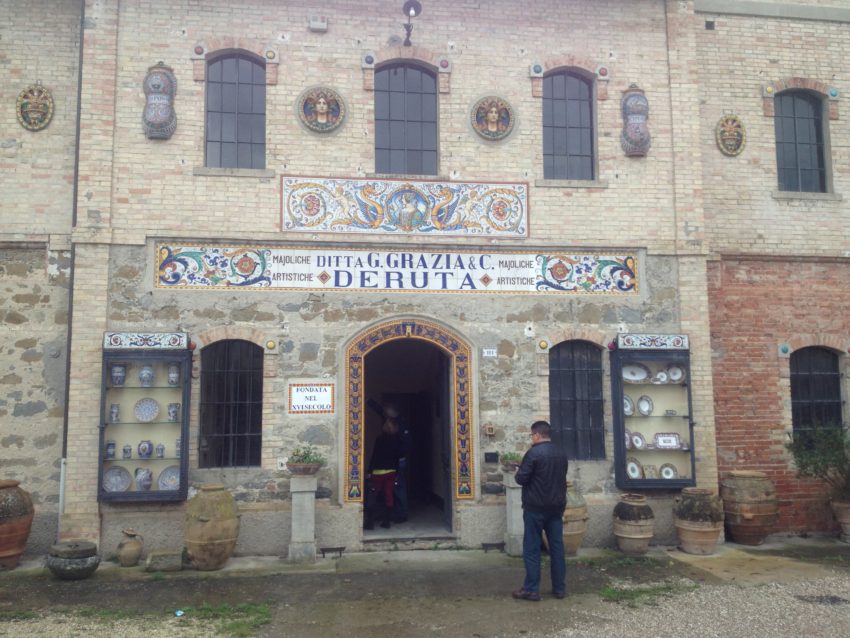
We started our adventure in the town of Deruta. Deruta is to ceramics what Barolo is to wine, Venice is to gondolas, the Vatican is to Catholicism. It’s a town of 9,000 and every building along the main road appears to be a ceramics shop. The windows are filled with brightly painted pots, plates, vases, olive oil canisters, serving trays, wall hangings. I think I saw a kitchen sink made of ceramic, too.
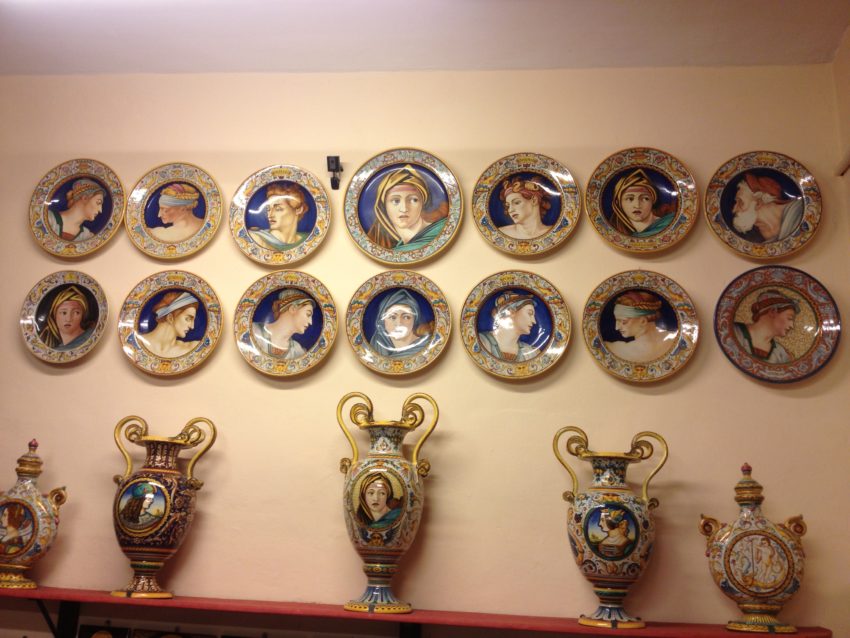
We stopped at Ubaldo Grazia, probably the highest-end shop in town and the most famous. It has pieces in Tiffany’s, Saks and many shops along New York’s Fifth Avenue. George Clooney, who has a villa on Lake Como, bought a 16-piece dinnerware set from Ubaldo. Francis Ford Coppola, a wine maker as well as a director, bought pieces decorated with grapes and vineyard leaves. Mel Gibson and Andy Garcia are regular customers. All four of The Beatles signed the guestbook, dated 1964.

The designs are spectacular. Colors of blue and yellow and red, as bright as fall leaves in the Umbrian countryside, explode over snow white pottery in flowing designs. Swirls and flowers and birds and dragons, each one is individually hand painted in a workshop you can visit during working hours. It wasn’t a ceramics shop. It was an art museum.
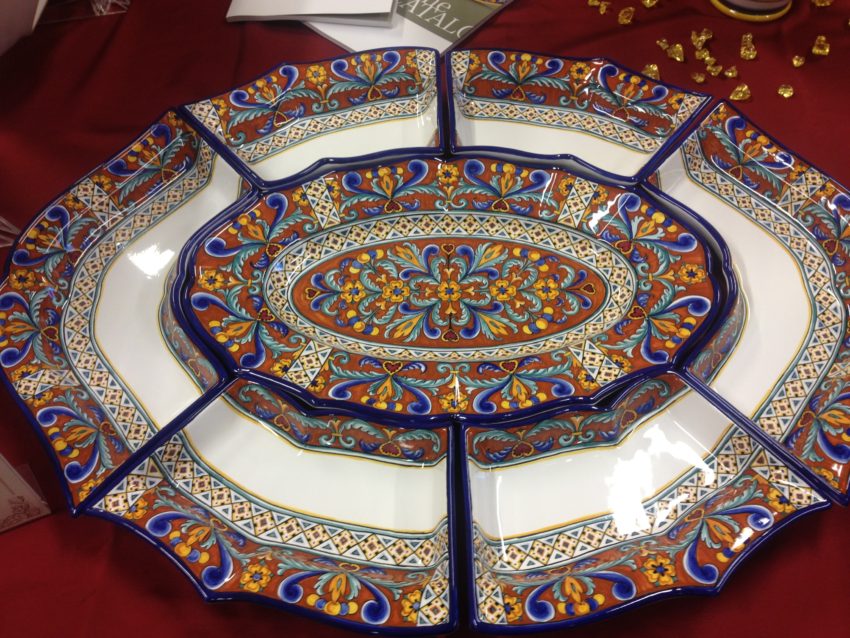
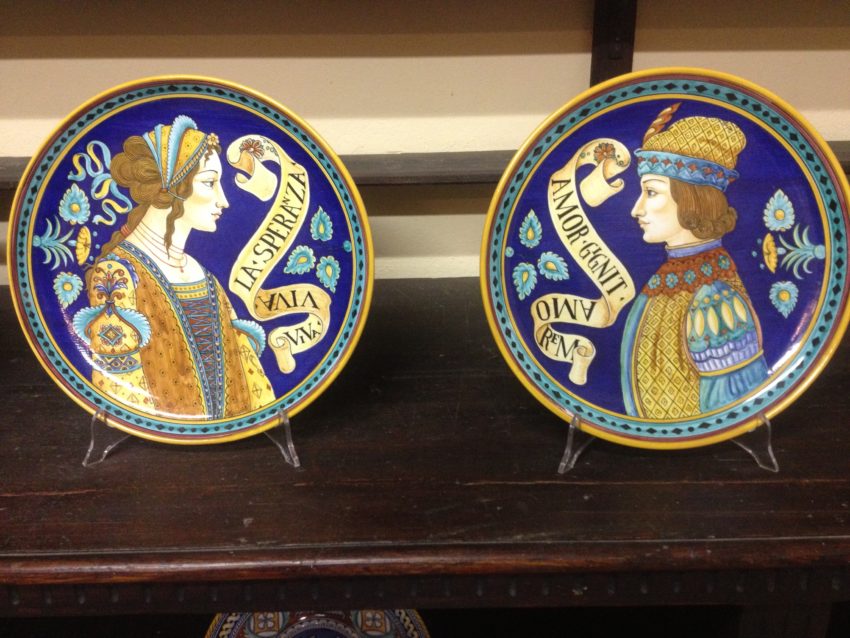
The style hasn’t changed much. The prices, however, sure have. I was in the market for an olive oil and vinegar canister set and the one I saw was a hefty 125 euros ($140). A dinner plate was 180 euros. If any one of us had bought so much as a table setting for two we’d wipe out our budget for October. Pam, however, is on vacation. When you’re on vacation and have a job, money isn’t an option when it comes to outfitting your home with dinnerware from Italy that dates back five centuries. She bought two dinner plates, two foundation plates and a serving bowl for a price I was afraid to look at for fear of terminal sticker shock.
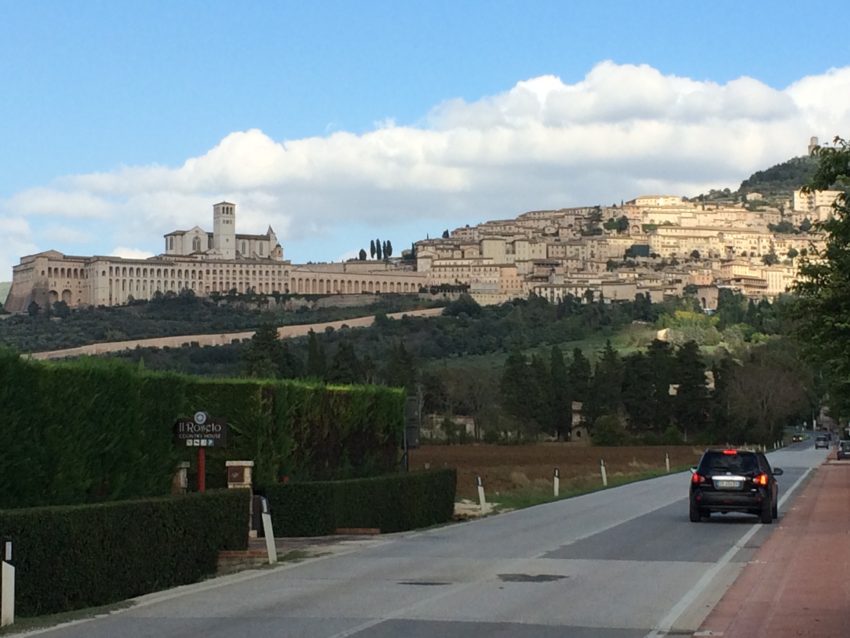
Our next stop was the one place in Umbria on nearly every tourist’s bucket list. Travelers have gone to Assisi for, oh, nearly 900 years. Francis Bernardone, better known today as St. Francis of Assisi, remains the most beloved saint in the history of the Catholic Church. It wasn’t until I visited Assisi my first time in 2002 when I really understood his impact on the world. Born in Assisi as a spoiled kid to a wealthy merchant, he played the part of an entitled brat until he saw a holy vision in his 20s. He then stripped himself of all wealthy trappings and dedicated his life to helping the poor, much to his old man’s chagrin. Francis traveled around Umbria and beyond preaching Christ’s word, setting up monasteries and, allegedly, performing miracles such as curing the sick and talking with animals. Keep in mind, Italy in the early 13th century was a war-torn peninsula where the Papal States battled for control with the Holy Roman Empire. Back then, peace wasn’t a big conversation topic. Yet St. Francis’ word carries to this day. So beloved by the church, he was canonized only two years after his death in 1226. He was 44.
Assisi hasn’t changed much since Francis roamed its narrow alleys in a peasant robe. Our car approached from below and the Basilica di San Francesco, all 42,000 square feet, fills up nearly half the town. It anchors the left side of the hill like a battleship. With its arched porticoes and imposing bell tower, the massive, yellow-white exterior can be seen all over Umbria.
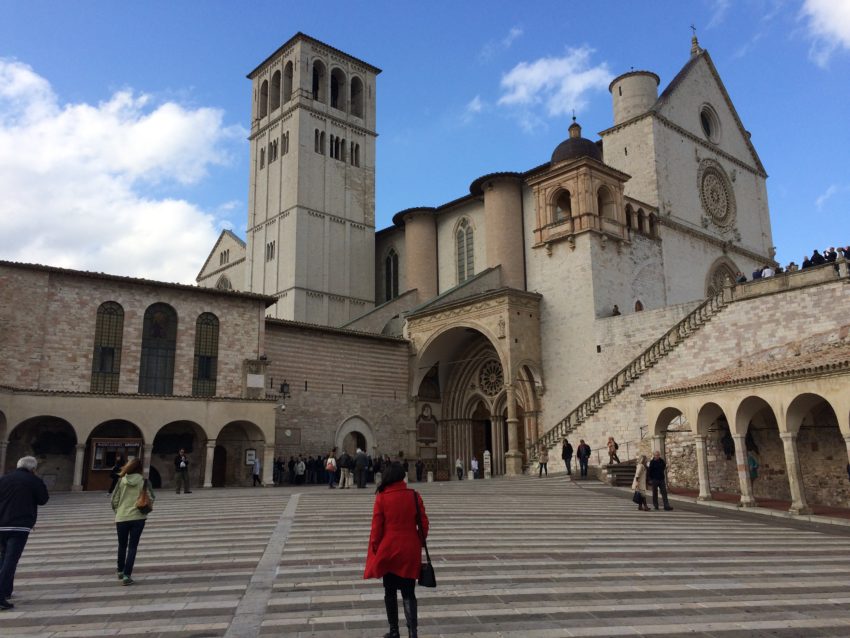
Arriving shortly before noon is not the best time to see Assisi. I tell visitors to Italy that when you visit touristy towns, spend the night. Assisi. Siena. Positano. I also include the independent republic of San Marino tucked in the corner of Le Marche. When the sun goes down and the tourists return to their bases in Rome or Naples or Milan, these little historical towns change dramatically. The locals come out. The night spots open. I spent my first trip to Assisi in 2002 hanging out in a local cafe talking to locals in their 20s and 30s about life in a tourist trap. They were wonderfully entertaining, gracious and insightful. About the only locals I saw on this recent trip were Franciscan monks conducting tours and selling souvenirs inside the basilica.
The entire church is a tribute to its favorite son. I walked in past a man in a brown hoodie talking to a tour group and stared at the violent scene above me. One of four frescoes, depicting St. Francis’ victory over evil, shows a demon covered by a snake surrounded by skulls. It looked more like hell than heaven.
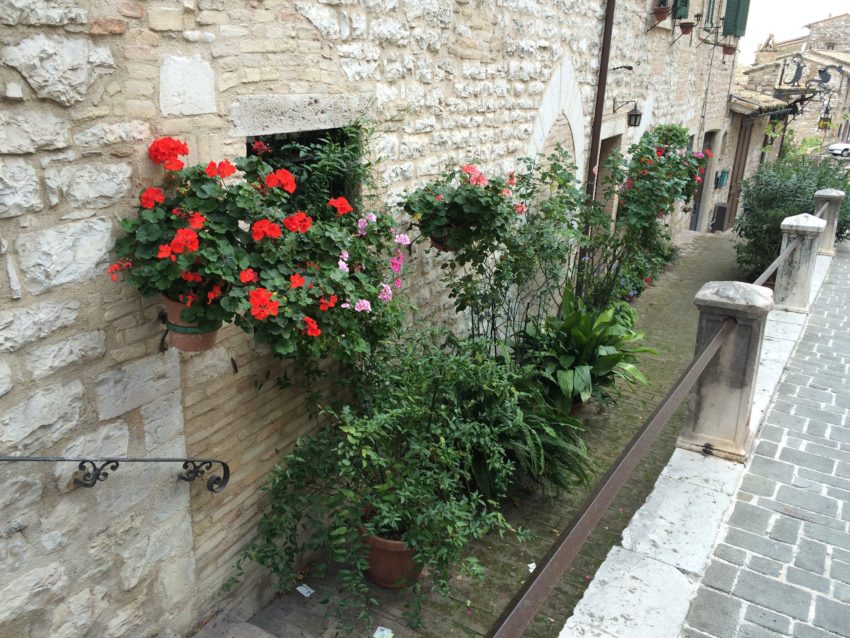
I walked down a small flight of stairs where the church still keeps St. Francis’ body. Next to the small tomb I saw a man in a gray windbreaker and beard, on his knees and his hands together and eyes closed, quietly moving his lips to a prayer only he could hear. On the other side, I saw another man doing the same, two bookends holding up a saint who has lured pilgrims here for half a millennium.
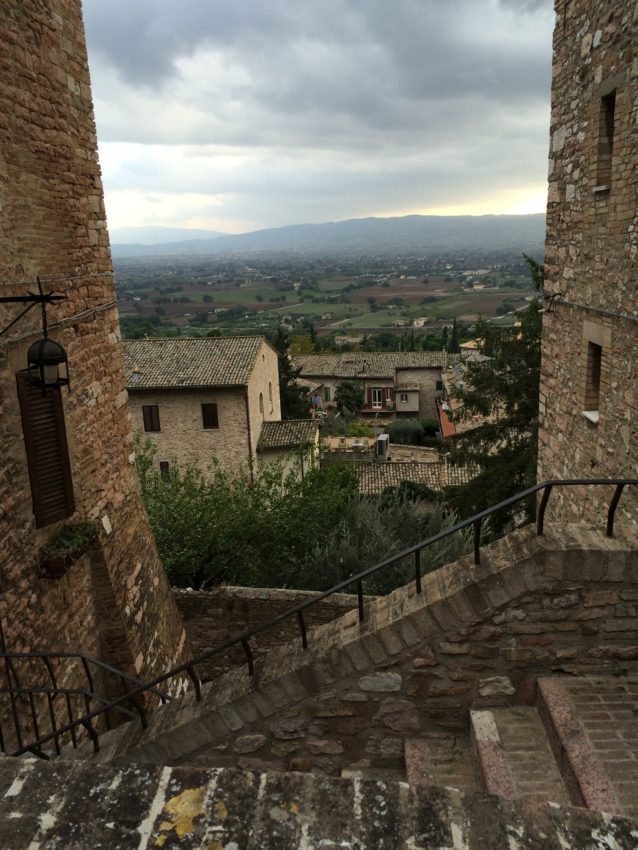
In the upstairs church, built after the lower church between 1230 and 1253, I could see why. Ringing the upper walls are 28 frescoes depicting St. Francis’ life. There is St. Francis wearing flowing, elaborate clothes and another of him wearing rags and telling his exasperated father he would dedicate himself to the poor. In others he’s talking to angels. In others he’s talking to animals. In the background I could hear the melodic, high-pitched singing of Franciscan monks over the loudspeaker. Even for a heathen like myself, Basilica di San Francesco makes me feel the history of the Catholic Church if not its god.
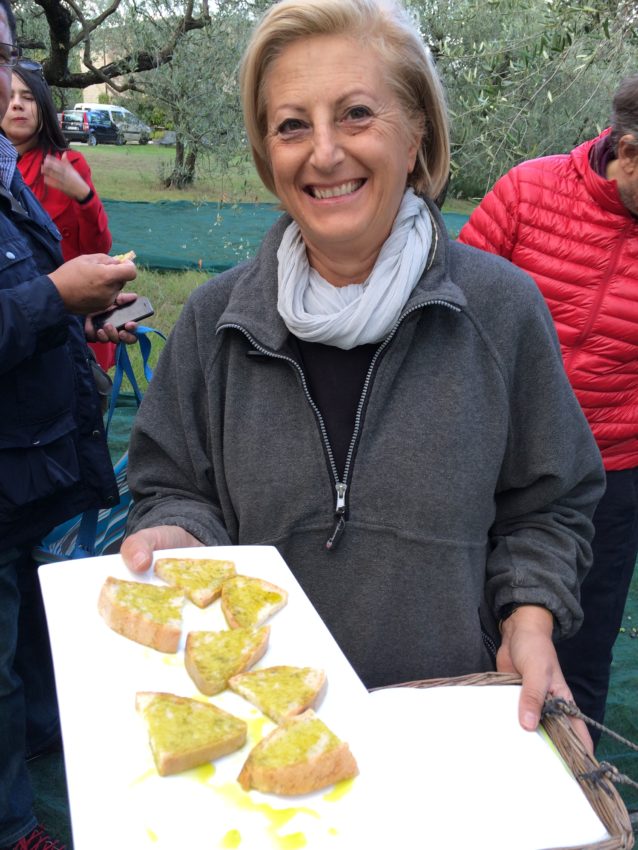
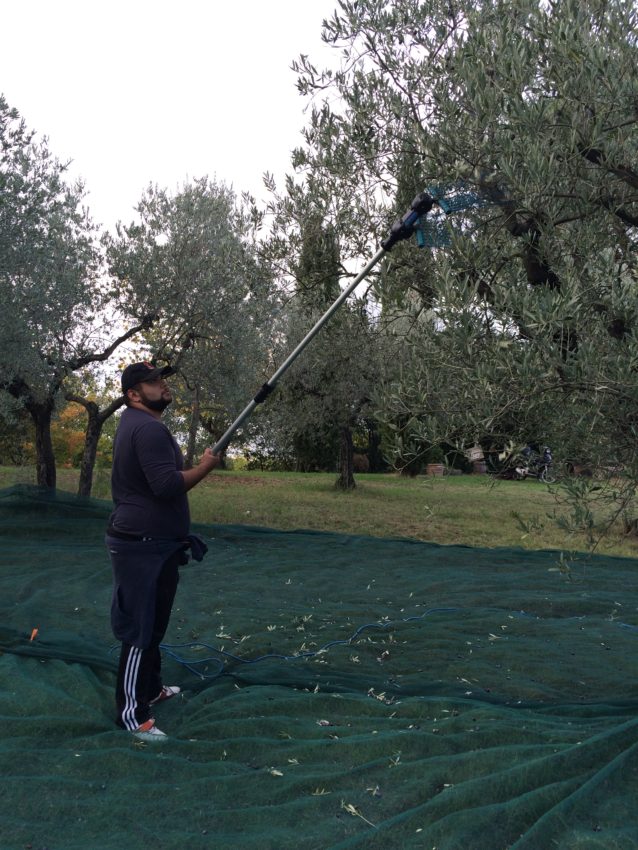
After I leave a holy place such as San Francesco or St. Peter’s or the Duomo in Milan, I want to do only one thing: drink. Umbria does not have the name cache as its neighbor to the north, Tuscany, but Umbrian wines are under-appreciated and, frankly, under-priced. We went to the tiny village of Bevagna where we first stopped at Casa Gola, in the middle of olive orchards that produce some of the best olive oil in Italy. Casa Gola also offers classes in cooking dishes you will find nowhere in the United States. While we watched a worker pull olives off trees with what looked like a plastic motorized clipper, Casa Gola’s Luciana Cerbini served us all trays of bruschetta dripping with her incredible olive oil. Like salami sandwiches in the Swiss Alps, bruschetta in extra virgin olive oil always tastes better in an olive orchard.
Leonardo has a friend who owns a terrific winery in Bevagna called Terre dei Nappi. Terre dei Nappi is the epitome of the little Italian country winery. It has no showroom, no tour buses, no souvenir T-shirts.
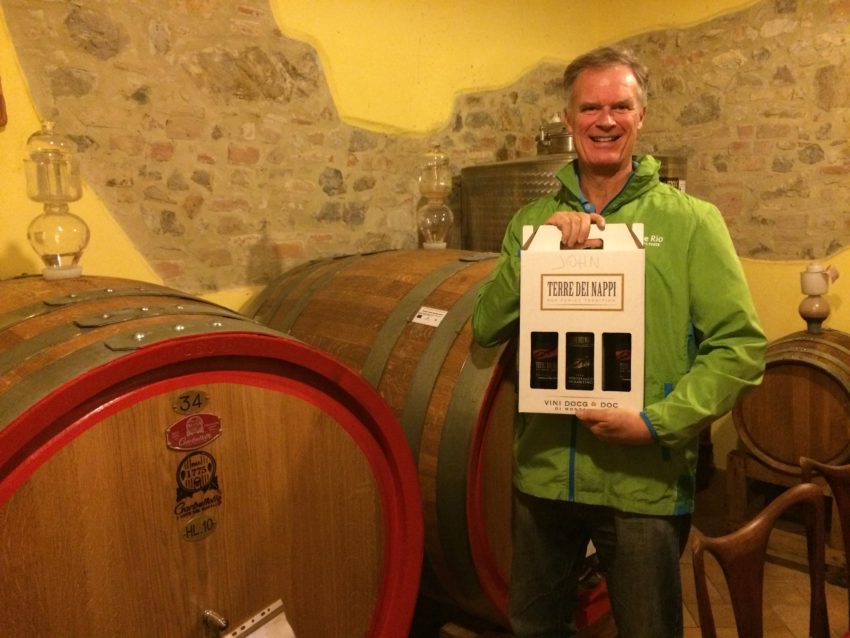
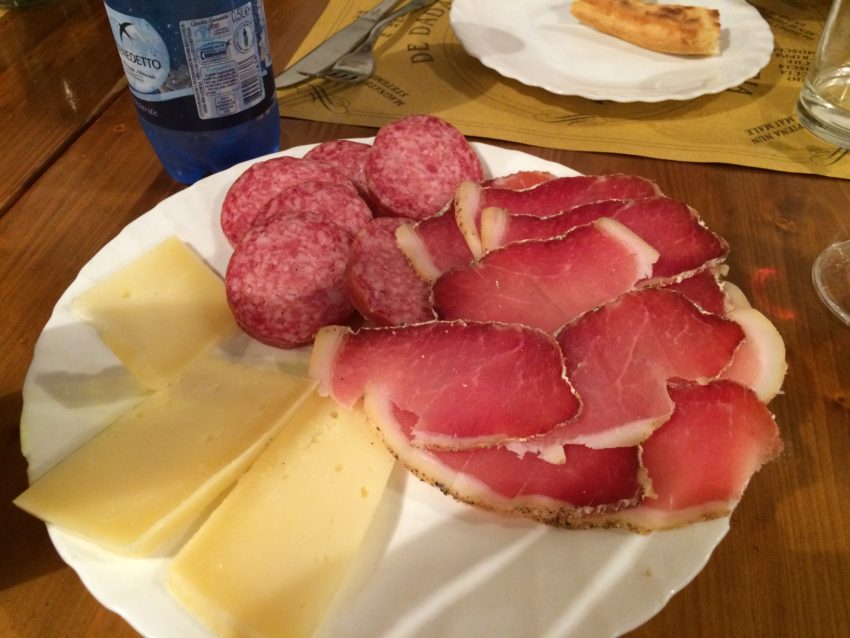
The heads of the winery, as they did last year, opened their little showroom for us and brought out a half dozen bottles of wine — along with plates of prosciutto, salami, cheeses and bread. Each bottle, from the dry Montefalco Rosso to the sweet Passito dessert wine, had us oohing and aahing like bleating sheep. I came away with two bottles of Montefalco Rosso and one of the slightly sweeter Montefalco Sagrantino, all for about 30 euros ($34). In the U.S., three bottles of this quality of wine might top $100.
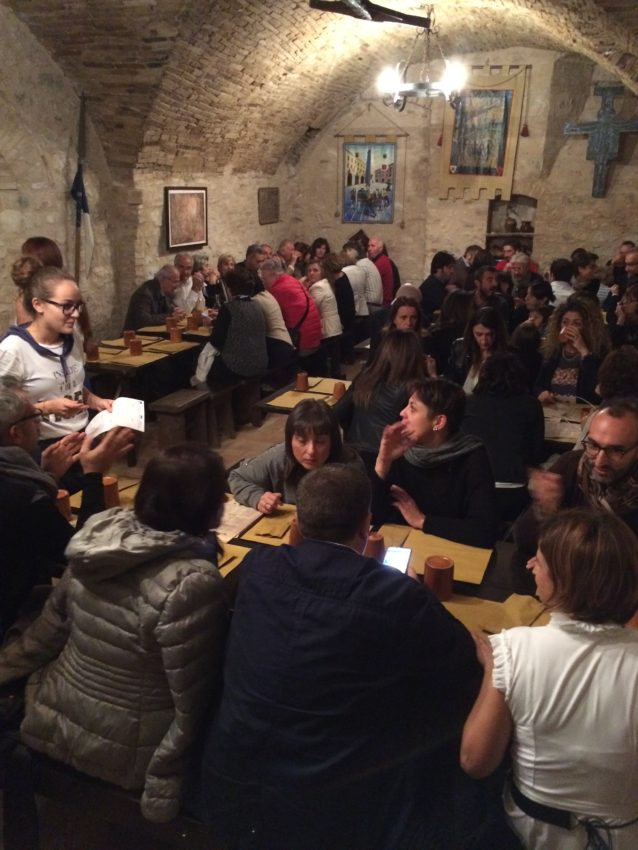
Also underrated is the Umbrian cuisine. People here are notably proud of it to the point where they hold festivals for nearly every delicacy on their food chain. Or have you never heard of the snail festival in Cantalupo? It’s every August. Or the onion festival in Cannara? It’s every September. In October, the town of Trevi celebrates the one food no one can live without …
… celery.
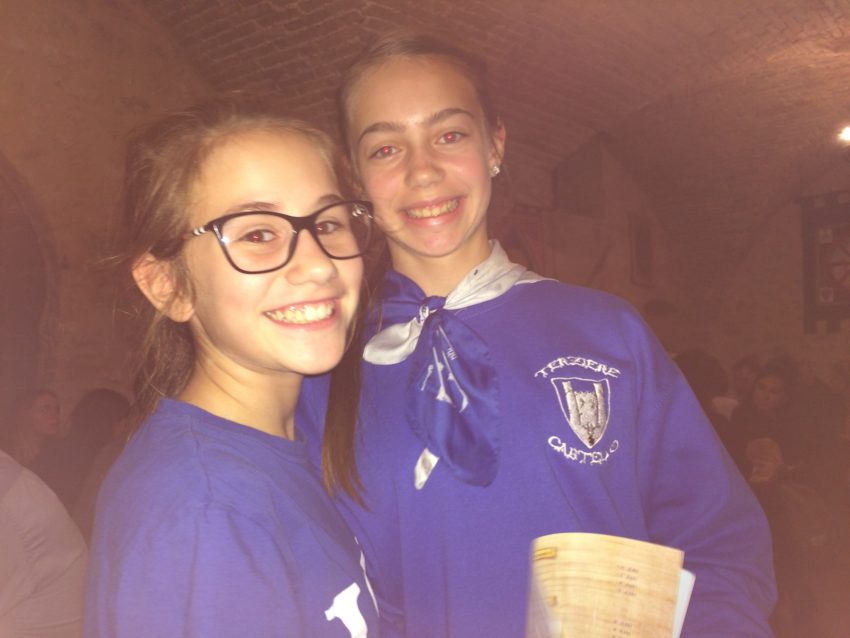
Yes, Trevi has a celery festival every October. It is the only month of the year the town opens Terziere Castello, a sprawling restaurant that looks like a movie set for a film about the Middle Ages. The curved stone ceiling makes you feel as if you’re inside a cave. Iron chandeliers hang from the ceiling. Wide, bulky drinking cups look perfect for grog. A man sitting at the table next to ours ate a turkey leg with his hand. I wanted to call a waitress by yelling, “Hey, scullery wench!” Instead, waiting our table were girls 13 and 12 years old.
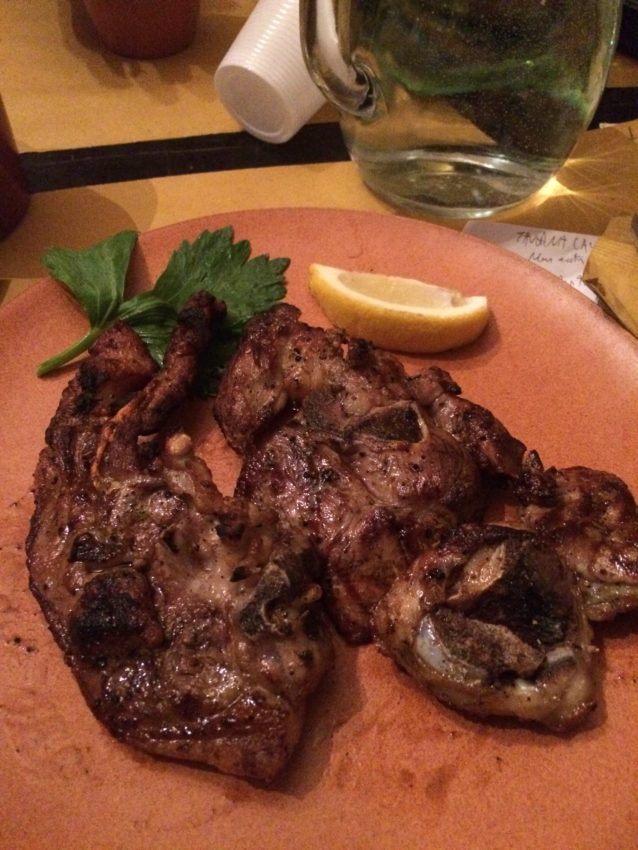
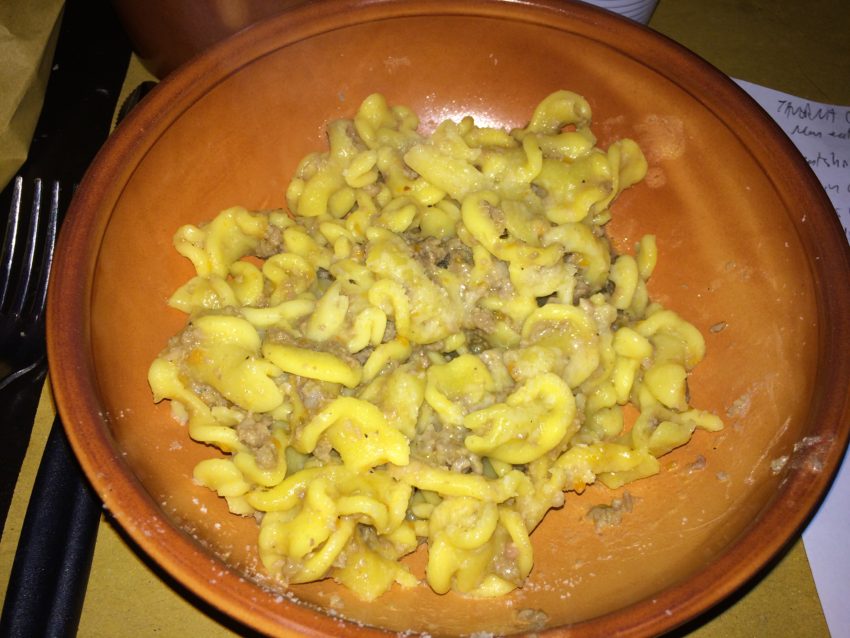
The menu, obviously, was heavy on the celery, called “sedano” in Italian. Zuppa di Sedano (Celery Soup), Parmigiana di Sedano (Celery covered in parmesan cheese), Sedano Ripieno (Stuffed Celery), Sedano in Padella (Celery in a pan), Sedano alla Popolana (loosely translated: Peasant Celery). There’s even a celery dessert. I had the Fantasie di Chianina. It’s a chunky pasta made from chianina, one of the largest and oldest breeds of cow in the world and found in Umbria, Tuscany and Lazio, the region surrounding Rome. The cows are white and used for the famous steaks in Latini, the Florence steakhouse that I’ve written is the best in the world. For the second course I had Arrosticini di Pecora, roast lamb. It was as delicate, lean and fresh as if slaughtered at my table.
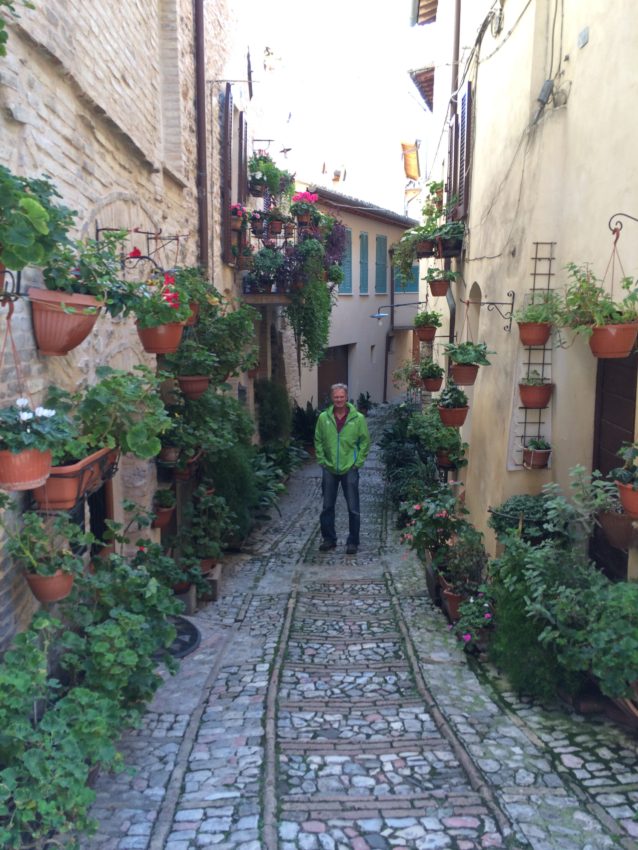
The next day we made a return trip to Spello, the cute, walled town lined with blooming flower beds, stone archways, narrow cobblestone alleys and tasteful art stores and food stores. We stopped again at La Bottega Di Teresa, home to some of the best olive oil in Italy and fantastic honeys, cheeses and salamis hanging all over the store. Teresa informed me that my blog and photo of her last year helped make her the No. 1 alimentari (meat and cheese store) in Umbria. Since the number of my website’s subscribers could probably fit in her store, I told her the credit probably goes to her olive oils, honeys, cheeses and salamis.
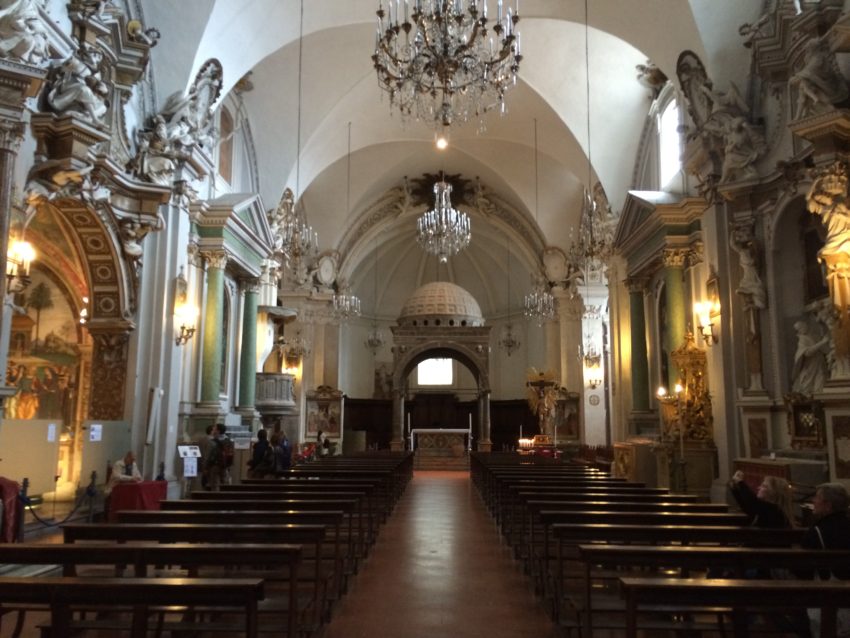
We arrived back in Rome early evening. Hugs and double cheek kisses were passed around. I helped haul Pam’s kitchen-full of souvenir craft ware to her apartment in Centro Storico. I carried my booty of wines and ceramic oil and vinegar canisters on the bus for home. Friends with no benefits? With places like Umbria only a couple hours away, there are always benefits.
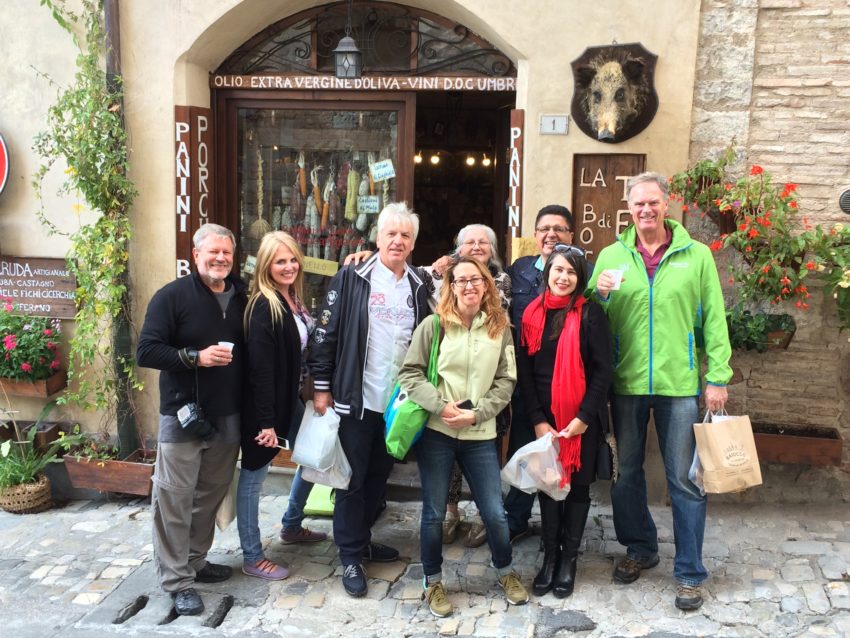


October 21, 2015 @ 8:14 am
Great trip, great company! I love Umbria, too, and I never thought about the fact that it’s the most “isolated” of all Italian regions. Good observation… yes, it might explain a lot about its appeal.
October 21, 2015 @ 8:27 am
Thanks, Rick. Along with La Marche, Umbria is also kind of Tuscany light. It has the same features as Tuscany (except for beaches) but with half the price and a quarter the tourists.
October 21, 2015 @ 7:45 pm
Your blog brought back so many memories of our week in AssisI and Umbria! Love your commentaries. Hugs, John.
October 21, 2015 @ 10:33 pm
We loved Spello! Spent a week there a few years ago. Funny we haven’t been back yet. I am trying to decide on a short trip in the near future. Sagratino di Montefalco is missing from our wine rack right now….
October 21, 2015 @ 10:59 pm
You can find Montefalco in some enotecas around Rome. Just ask. Tnanks for the note. Spello is such a special place. However, after only 48 hours the expensive ceramic oil and vinegar dispensers I bought there (made in Deruta) sported heavy brown stains from the oil and vinegar I put in them. I’m asking for an exchange which, in Italy, is like asking for an exchange with the pope.
October 22, 2015 @ 12:31 am
There’s nothing quite like buying wine from the person who made it, though, is there? Sorry to hear about your ceramics. I think the warranty expires before you even exit the store. Maybe you can return them to Nordstrom. They’ll take back anything.
October 26, 2015 @ 1:45 am
Next time we’re expecting you at the Trasimeno area where we live 🙂 thanks again for this blog post about Umbria. We love this region of Italy.
October 26, 2015 @ 1:48 am
Sounds great! I’d love to meet you and I look forward to reading your blog. Let’s stay in touch. I’m at Johnhenrome@hotmail.com.
John
October 26, 2015 @ 8:19 pm
Best article yet! Amazing pictures that, combined with your descriptive commentary, really provide a sense of the Umbria region – I shall have to add it to my intinerary for next trip to Italy. Love your blog!
October 27, 2015 @ 12:11 am
Thanks, Tamara. Fortunately, it’s not on every tourist’s itinerary. Otherwise, it wouldn’t be Umbria.